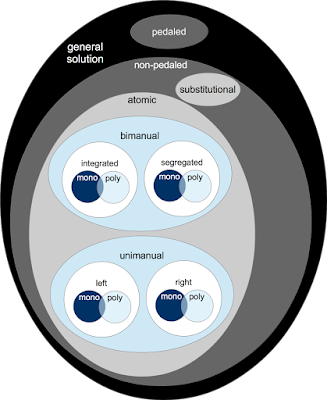Done
Administrivia
- Requested suspension of TAA support until next January (for tax purposes).
- Answered interview questions for College of Engineering story on Fifty for the Future award.
Model Building
- Completed Sayegh implementation.
- Learned how to modify TatSu AST.
- Implemented "pivot alignment" evaluation method.
- Refactored code for better reuse in new models, especially for segmenting input.
- Fixed how first and last fingering were being constrained to ensure model preferences for second and penultimate fingerings were not ignored.
- Drafted ISMIR abstract.
- Drew a diagram of the subproblems in the domain.
Doing
- Writing up what we have done so far.
- Reimplementing Parncutt model in framework using networkx.
- Developing better test cases for Sayegh.
- Implementing crude automatic segmenter.
- Updating abcDE to support manual segmentation.
- Completing and polishing abcD for entire Beringer corpus.
- Defining initial benchmark corpora and evaluation methodology.
- Implementing convenience methods for reporting benchmark results.
Struggling
- Sayegh model produces results that do not seem consistent with training data provided.
In Scope
- Moving Beringer corpus to MySQL database.
- Enhancing Parncutt, following published techniques and pushing beyond them.
- Enhancing Hart and Sayegh to return top n solutions.
- Re-weighting Parncutt rules using machine learning and TensorFlow. (This seems like a good fit.)
- Adding support to abcDE for annotating phrase segmentation.
- Debugging Dactylize 88-key circuit.
- Collecting fingering data from JB performances in Elizabethtown.
- Completing Dactylize II circuit.
- Developing method to align performance data with symbolic data. I think this is going to be essential if we are to use Dactylize data moving forward and a key part of its proof of concept. I plan to have something for this at the ISMIR demo session (September 22 deadline).
- Defining procedure for sanity test of production automatic data collector (including Beringer data).
- Defining corpora for Dactylize data collection (WTC, Beringer, ??).
- Implementing end-to-end machine learning experiment, using Beringer abcD data.
- Submitting papers to TISMIR. Ideas: a follow-up demo paper describing Dactylize data collected; a full-length paper describing application of evaluation method to models developed; a full-length description of enhanced and/or novel models, demo of method to align collected performance data with symbolic score.
Done
Administrivia
- Talked through a few challenges with the NLP Lab.
- Did a little forum shopping. As a backup plan for ISMIR conference, the TISMIR journal is accepting submissions.
Model Building
- Completed "reentry" evaluation method for strike fingers.
- Tested edge cases for evaluation and advising methods.
- Rejected TensorFlow for Sayegh implementation. We just need a trellis graph, a nasty for loop for training, and Viterbi.
- Stubbed in support for phrase segmentation in modeling framework.
- Implemented Sayegh training algorithm.
- Implemented methods to store and recall trained models for reuse.
Doing
- Implementing Sayegh trellis-graph model from scratch, using Python's networkx.
- Defining initial benchmark corpora and evaluation methodology.
- Implementing convenience methods for reporting benchmark results.
- Completing and polishing abcD for entire Beringer corpus.
Struggling
- The otherwise slick parser module I am using (TatSu) produces an immutable AST. This is cramping my style and promises to get worse as we move along.
- The Parncutt code is a disaster under Python 3. Lot of rework needed here.
In Scope
- Reimplementing Parncutt model in framework using networkx.
- Moving Beringer corpus to MySQL database.
- Enhancing Parncutt, following published techniques and pushing beyond them.
- Enhancing Hart and Sayegh to return top n solutions.
- Re-weighting Parncutt rules using machine learning and TensorFlow. (This seems like a good fit.)
- Adding support to abcDE for annotating phrase segmentation.
- Debugging Dactylize 88-key circuit.
- Collecting fingering data from JB performances in Elizabethtown.
- Completing Dactylize II circuit.
- Developing method to align performance data with symbolic data. I think this is going to be essential if we are to use Dactylize data moving forward and a key part of its proof of concept. I plan to have something for this at the ISMIR demo session (September 22 deadline).
- Defining procedure for sanity test of production automatic data collector (including Beringer data).
- Defining corpora for Dactylize data collection (WTC, Beringer, ??).
- Implementing end-to-end machine learning experiment, using Beringer abcD data.
- Submitting papers to ISMIR 2018. Abstracts due March 23. Papers due March 30. Ideas: a follow-up demo paper describing Dactylize data collected; a full-length paper describing application of evaluation method to models developed; a full-length description of enhanced and/or novel models, demo of method to align collected performance data with symbolic score.
